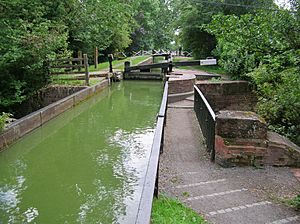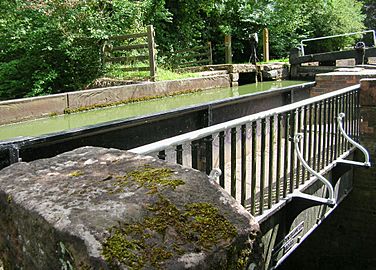Yarningale Aqueduct facts for kids
Quick facts for kids
Yarningale Aqueduct
|
|
|---|---|

Yarningale Aqueduct, looking south towards lock 34
|
|
| Lua error in Module:Location_map at line 420: attempt to index field 'wikibase' (a nil value). | |
| Maintained by | British Waterways |
| Characteristics | |
| Total length | 42 feet (13 m) |
| Width | 9 feet (2.7 m) |
| History | |
| Construction start |
|
| Opened | 1834 (current) |
The Yarningale Aqueduct is a special kind of bridge that carries a canal over a stream or valley. It's one of three such structures on a 6-kilometer (about 3.7 miles) part of the Stratford-upon-Avon Canal in Warwickshire, England. This aqueduct crosses over the Kingswood Brook, close to the village of Claverdon. What makes these three aqueducts unusual is that the paths next to the canal, called towpaths, are at the same level as the bottom of the canal itself.
Building the Yarningale Aqueduct
The first Yarningale Aqueduct was built a long time ago, between 1812 and 1816. It was made of wood. This aqueduct was designed to let one boat at a time pass over the local stream. It was about 42 feet (12.8 meters) long.
This aqueduct leads right into the 34th lock on the canal. This lock is known as "Bucket Lock." It's the middle lock in a group of three locks in the Claverdon area. Locks are like water elevators that help boats move up or down between different water levels on a canal.
Rebuilding After a Flood
In 1834, something big happened. The Yarningale Aqueduct was completely destroyed! Heavy flooding from both the canal and the nearby Grand Union Canal caused a huge surge of water. This powerful surge washed away the wooden structure.
But the aqueduct was quickly rebuilt in the very same year. This time, it was made from strong cast iron by a company called Horseley Ironworks. This new, stronger design helped it stand up to future challenges.
Images for kids


